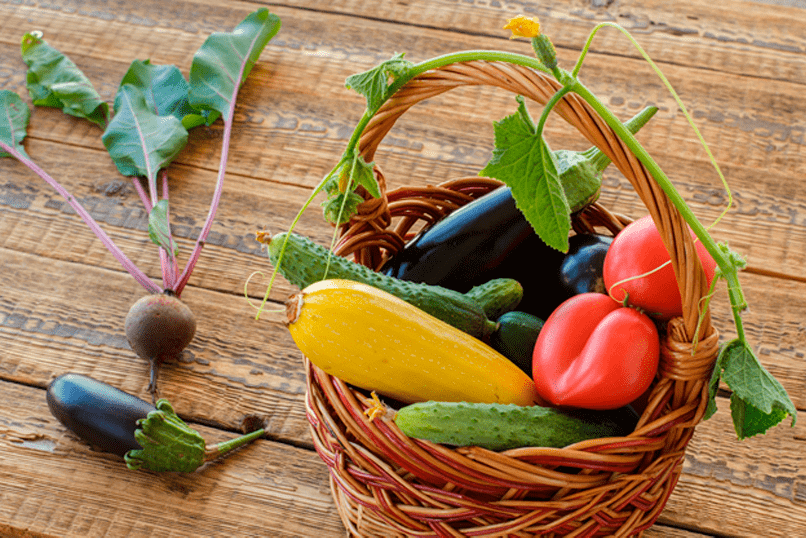Tomatoes, peppers, cucumbers, green beans, peppers, squash, carrots, beets, zucchini—these veggies and more are growing in gardens all over. Garden season is officially underway, and people everywhere are patiently watching their plants grow and flower.
It’s not too late to get your vegetable garden started, though. In some areas, it’s barely past the last freeze date, so now is still the perfect time to get some veggies in the ground.
“By growing your own vegetables you may end up eating more, which is good for the health of most,” Dr. Leonard Perry, University of Vermont extension professor writes. “Research continues to show that those who eat more fruits and vegetables are less likely to have chronic diseases such as strokes and cancers. You can get vitamins and minerals from supplements, but produce contains other natural compounds (such as anti-oxidants to help prevent cancers) as well that may help protect you from chronic disease. Research shows too that most don’t eat enough of these each day.”
Are you ready to get your vegetable garden started? Here are some tips, must-have tools, and ideas for what to do with your garden bounty:
Tips
You don’t need to be a certified master gardener to start a garden. But it’s essential to have a little gardening knowledge before you begin planting. Here are some basic tips:
- Know your dates.
When’s the average last and first frosts of the year? That indicates when you can start planting warm-weather veggies like tomatoes and when you need to pick everything or cover plants before the first frost destroys your crops. It’s also important to know the days-to-maturity for everything you plant. If the number is higher than the number of days until the first frost, you probably won’t get anything from that plant. So choose something with a shorter harvest time.
- Choose a method.
Following a tried-and-true gardening method may be your best bet for a successful garden if you’re a novice. There are a lot from which you can choose: Mittleider, square-foot, no-till, straw bale, hugelkultur, and more. There are books and step-by-step instructions available online for more information.
- Decide what to grow.
It may sound like a good idea to grow parsnips and turnips, but if you and your family won’t eat them, it’s a waste of time, space, and energy. So only choose veggies you want to eat.
- Map it.
If you’re planting multiple varieties of plants that look alike, make a map or list of what everything is and where you planted it. Then you’ll know where everything is and when to harvest.
- Watch for bad bugs.
Aphids, slugs, and snails will destroy your plants and fruit before you have a chance to harvest. Luckily, there are easy and safe ways to kill these bugs without pesticides that could upset your garden neighbors. For aphids, make an insecticidal soap with a few teaspoons of dish soap and a quart of water. Spray the solution on your aphid-infested plants. Ladybugs and lacewings also will eradicate bad bugs in your garden, and you can buy them on Amazon. A bowl of beer is an easy way to get rid of slugs and snails. Put out a shallow bowl filled with beer. Slugs and snails are attracted to the liquid and will drown.
Tools
You don’t need expensive equipment to take care of your garden. A few simple tools are all you need to prep your soil, plant, and take care of your garden. Here’s a short list to get started:
- Shovel
- Hoe
- Cultivator or hand fork
- Garden gloves
- Cart
- Pad for kneeling
- Scissors
- Pruning shears
- Trowel
Bounty Ideas
When your zucchini starts producing, tomatoes ripen, and green beans are filling the vines, it’s easy to be overwhelmed. But don’t panic, and don’t eat a garden salad with every meal (unless that’s your goal). Cooking with garden veggies is easy and makes for delicious meals. Here are some easy recipes:
- Garden Vegetable Pie
- Fried Green Tomatoes
- Zucchini Cups
- Smokey Tomato Salsa
- Zucchini Garlic Bites
- Grilled Stuffed Jalapenos
- Beet Brownies
You also can start canning what you don’t eat. Water bath canning can be easy and safe—though sometimes time-consuming—with the right recipes.
Now, are you ready to get your hands in the dirt? It’s still the right time to start planting. To get started, make sure you have a little knowledge and the right tools. Then you’ll be ready to cook and eat what you grow. Don’t have garden space? Consider renting a plot in one of Provo’s community gardens!

